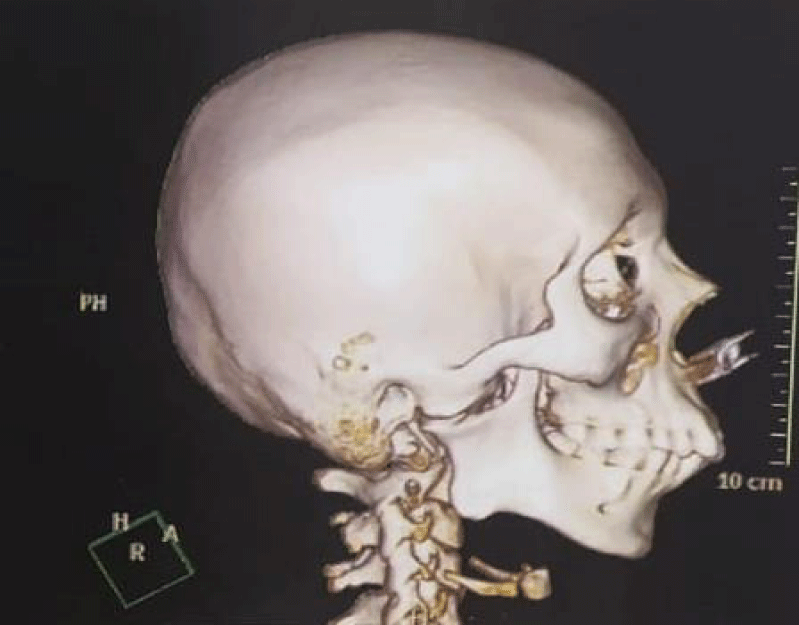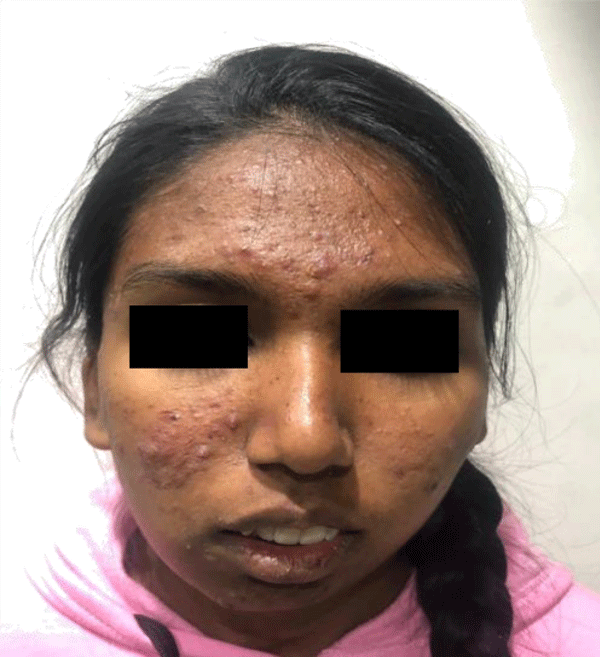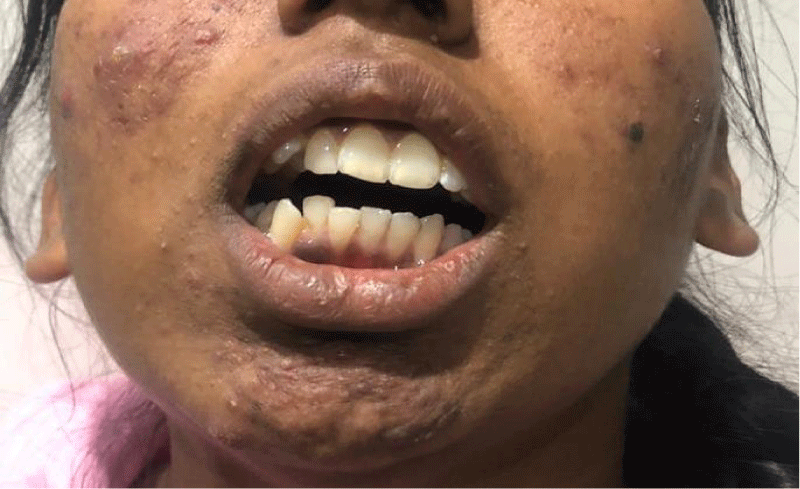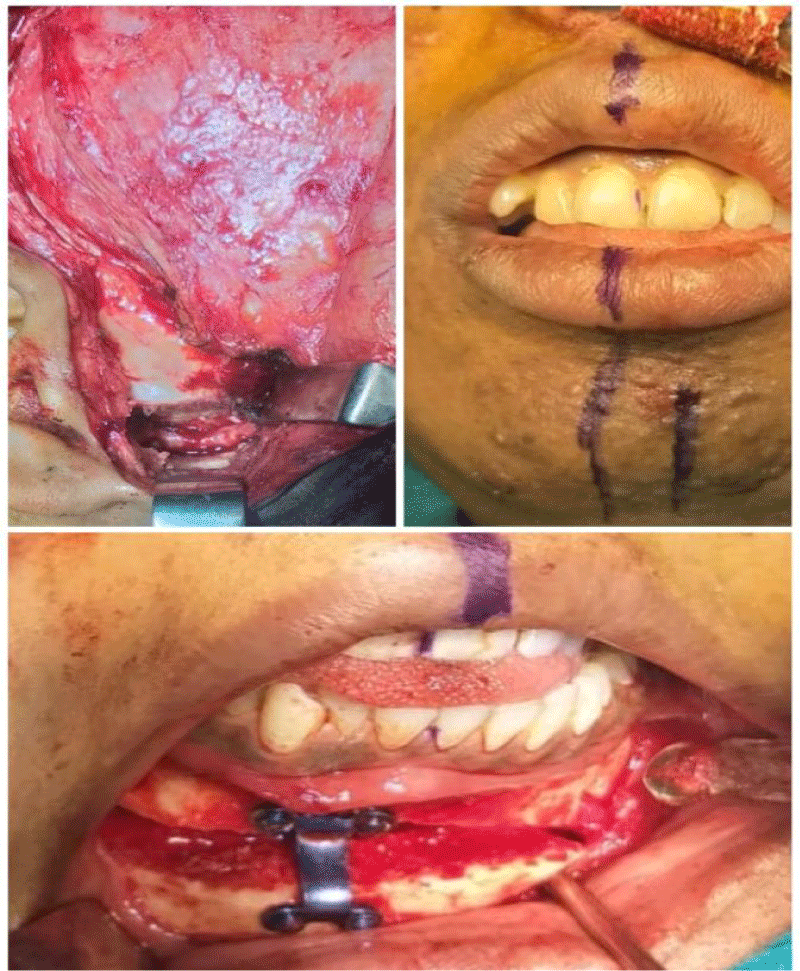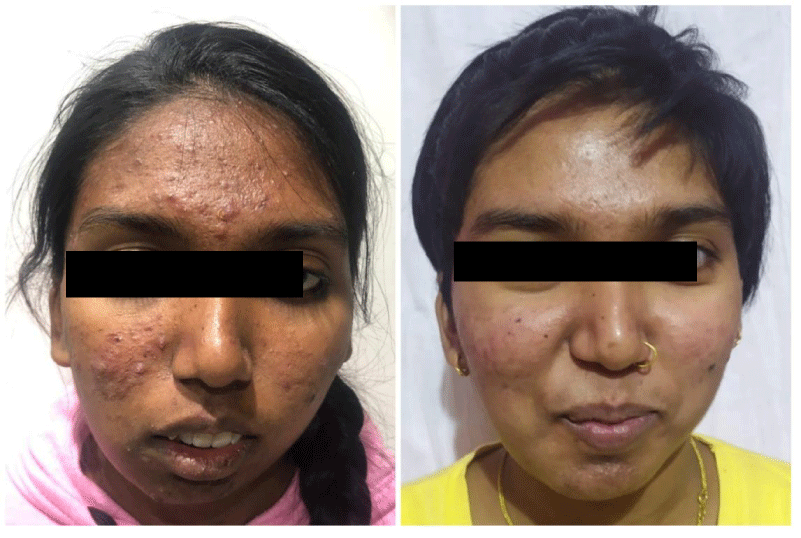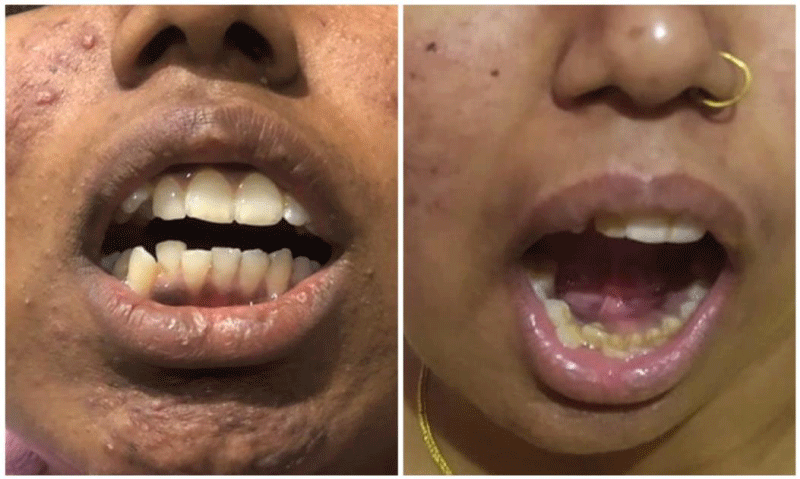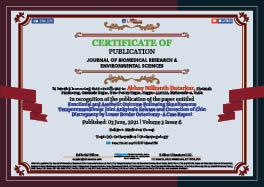> Medicine Group. 2021 June 03;2(6):439-442. doi: 10.37871/jbres1256.
Functional and Aesthetic Outcome Following Simultaneous Temporomandibular Joint Ankylosis Release and Correction of Chin Discrepancy by Lower Border Osteotomy-A Case Report
Abhay Nilkanth Datarkar1*, Hema Anukula1, Damayanti Walke1, Archana Deshpande1 and Anshul Rai2
2Department of Dentistry, All India Institute of Medical Sciences, Bhopal, India
Abstract
This is a case report of a 19 year old adult female with facial asymmetry secondary to right Temporomandibular Joint (TMJ) ankylosis with a history of previous surgery at the age of 10 years with gap arthroplasty for tmj ankylosis which was unsuccessful and lead to relapse .Because of decreased mouth opening and facial disfigurement patient was not able to have a quality life. She reported to our department where she got operated simultaneously for tmj ankylosis with interpositional arthroplasty using temporalis myofascial flap and novel osteotomy technique for correction of chin asymmetry. After surgery there is a significant improvement in patient both functionally and aesthetically.
Introduction
TMJ ankylosis is one of the known cause for facial asymmetry.It might be either a fibrous union or bony union of TMJ joint with the glenoid fossa resulting in reduction of mouth opening , difficulty in speech and mastication and leading to facial asymmetry [1]. According to a study conducted by Shuo Chen et al the rate of joint reankylosis among children was 19.1% which was significantly greater than that of the adults 7.3% [2]. Eventhough TMJ ankylosis when addressed at an early age which corrects the mouth opening but the facial asymmetry which is a result of this requires a second surgery for its correction. These problems not only effect the patient aesthetically and functionally but also creates a psychological trauma to the patient leading to a low self esteem life [3]. There are various surgical procedures for correction of facial asymmetry like genioplasty, distraction osteogenesis, orthomorphic and orthognathic surgeries [4]. Here, we are reporting a case of 19 year old female with right tmj ankylosis and facial asymmetry who got treated simultaneously with interpositional arthroplasty using a temporalis myofascial flap for ankylosis release and novel osteotomy technique for correction of chin asymmetry. In this novel osteotomy technique the chin discrepancy was measured preoperatively using the cephalograms and the asymmetry is corrected without affecting the status of occlusion. This simultaneous technique of TMJ ankylosis release and functional and aesthetic correction of facial asymmetry eliminates the need for repeated surgeries and hospitalization there by eliminating the complications of tomophobia [5].
Case Report
A 19 year old female patient reported to our department with cheif complaint of decrease in the mouth opening and facial disfigurement. Patient had a history of trauma in childhood which led to right TMJ ankylosis. Patient was previously operated for tmj ankylosis with gap arthroplasty in the year 2011 which was unsuccessfull and lead to relapse and reankylosis.
On clinical examination there were no relevant systemic diseases. The inter incisal distance was found to be 4mm. Patient had mandibular deficiency with chin deviated to right side .The lateral and forward movements of mandible were restricted. Lateral and posteroanterior cephalograms, three dimensional computed tomography of face was taken. Transverse discrepency of the chin was measured on the cephalograms using grummons analysis and it came to be 1.2 cm. Clinical photographs of the patient were taken. Bony width of mandible was measured using three dimensional CT scan of patient which reveals 12 mm in midline 9.2 mm on right side and 8.4mm on left body region. Then we have planned for simultaneous release of TMJ ankylosis and chin asymmetry correction under General anesthesia (Figures 1-3).
Procedure
After informed consent patient was posted for surgery under general anesthesia. Under all aseptic precautions first right tmj was exposed using Al-kayat Bramley incision. Then dissection was carried out through subcutaneous plane deep to temporalis fascia and dissection was carried further inferiorly to reach Zygomatic arch and then incision given at 45 degrees to zygomatic arch and layerwise dissection done. The bone ankylotic mass was removed using a bur and joint space was created and opposite side coronoidectomy also done. Mouth opening of 40 mm was acheived. Temporalis myofascial flap was interposed in the joint space created and secured with 3-0 vicryl sutures and layerwise closure done.
Next soft tissue and skeletal midlines were marked. After that circum vestibular incision given and full thickness mucoperiosteal flap reflected till molar region. Bilaterally mental nerves were dissected. Horizontal osteotomy cuts were marked below the mental foramen from first molar to contralateral side of first molar and vertical cut was marked perpendicular to horizontal cut and proceed with oscillating saw and bur. Osteotomy was completed by chisel and mallet and bony segment was separated using Smith spreader. Then 1.2 cm of bone that is present in excess on the unaffected side was removed and the osteotomised segments were shifted to left side to correct chin discrepancy. The excess bone removed was sandwiched between the two osteotomy segments and fixation was done by 8mm titanium chin plate and titanium screws in midline and 1 (4) hole continous titanium miniplate fixed with titanium screw at right body region. Thorough irrigation was done. Layerwise suturing was performed. Patient was advised to do mouth opening exercises and was followed up for 1 year (Figures 4-6).
Discussion
TMJ ankylosis may occur due to various reasons like trauma, infection, rheumatoid arthritis, ankylosing spondylitis and sometimes TMJ surgeries [6]. Diagnosing it in an early age and intervening it is of utmost importance .Because the complications of the TMJ ankylosis not only affect the patients physically, functionally but also creates an emotional and psychological distress to the patients. In somecases even though they got operated at an early age it may lead to relapse of ankylosis which is a failure of surgery [7]. This is one of the case where patient got operated previously with gap arthroplasty but it was unsuccessful leading to relapse. Patient was having reduced mouth opening and facial disfigurement because of which she was not able to present herself confidently in the society. Although some surgeons recommend a staged approach for the treatments of patients with TMJ ankylosis and related secondary deformities, others prefer to release the ankylosis and correct the deformities simultaneously [3,7-9]. The results were acceptable but due to distraction there is change in the occlusal plane which requires more vigorous orthodontic treatment and time [10-13].
We planned her surgery for a simultaneous release of tmj ankylosis along with facial asymmetry correction. There are various surgical procedures for correction of facial asymmetry like genioplasty, distraction osteogenesis, orthomorphic and orthognathic surgeries [9,14]. But all of this procedures have their own limitations. The main advantage with this novel osteotomy technique is we were able to correct the asymmetry of chin without changing the status of occlusion and it restores the three dimensional harmony of the face. Good chin contour and mentolabial relation was acheived. Profile of the patient was improved from convex to straight.There is improvement in the airway of the patient. In our case report release of TMJ ankylosis and simultaneous correction of facial asymmetry the occlusal plane is not disturbed thus post orthodontic treatment time is less. This simultaneous release has more beneficial effects as in only one operation the patient gains both psychological benefit of having a more normal face and good mouth opening [8,15,16]. This simultaneous procedure reduces the duration of treatment time, repeated hospitalisation, the expenses and also the complications of tomophobia [16].
Conclusion
This paper presents a case of adult TMJ ankylosis patient with facial asymmetry where simultaneous surgery was done for functional and aesthetic correction of the face by interpositional arthroplasty with temporalis myofascial flap and novel osteotomy technique for lower border correction. This novel osteotomy design is more conservative as compared to present orthomorphic procedures for correction of facial asymmetry and very effective with quick results. This procedure improves facial esthetics of patient, brings chin towards midline, restores vertical, anteroposterior and horizontal harmony of face, improves pharyngeal airway and aids in treatment of sleep apnea with minimal intraoperative and postoperative complications and complete functional recovery of patient within 3 postoperative days. The results of this simultaneous technique of tmj ankylosis release and facial asymmetry correction are encouraging to achieve a functional and aesthetic balance in adult patients.
References
- Long X, Li X, Cheng Y, Yang X, Qin L, Qiao Y, Deng M. Preservation of disc for treatment of traumatic temporomandibular joint ankylosis. J Oral Maxillofac Surg. 2005 Jul;63(7):897-902. doi: 10.1016/j.joms.2005.03.004. PMID: 16003613.
- Chen S, He Y, An JG, Zhang Y. Recurrence-Related Factors of Temporomandibular Joint Ankylosis: A 10-Year Experience. J Oral Maxillofac Surg. 2019 Dec;77(12):2512-2521. doi: 10.1016/j.joms.2019.06.172. Epub 2019 Jul 2. PMID: 31348873.
- Vibhute PJ, Bhola N, Borle RM. TMJ Ankylosis: Multidisciplinary Approach of Treatment for Dentofacial Enhancement-A Case Report. Case Rep Dent. 2011;2011:187580. doi: 10.1155/2011/187580. Epub 2011 Sep 20. PMID: 22567429; PMCID: PMC3335446.
- Salins PC, Venkatraman B, Kavarody M. Morphometric basis for orthomorphic correction of mandibular asymmetry. J Oral Maxillofac Surg. 2008 Jul;66(7):1523-31. doi: 10.1016/j.joms.2007.06.683. PMID: 18571045.
- Zhu S, Jiang Y, Pokhrel N, Hu J. Simultaneous Correction of Temporomandibular Joint Ankylosis and Secondary Dentofacial Deformities in Adult Patients: Surgical Technique, Treatment Outcomes, and a Consideration of the Factors Involved. J Craniofac Surg. 2015 Nov;26(8):2351-6. doi: 10.1097/SCS.0000000000002085. PMID: 26517460.
- Sporniak-Tutak K, Janiszewska-Olszowska J, Kowalczyk R. Management of temporomandibular ankylosis--compromise or individualization--a literature review. Med Sci Monit. 2011 May;17(5):RA111-6. doi: 10.12659/msm.881755. PMID: 21525821; PMCID: PMC3539597.
- Elgazzar RF, Abdelhady AI, Saad KA, Elshaal MA, Hussain MM, Abdelal SE, Sadakah AA. Treatment modalities of TMJ ankylosis: experience in Delta Nile, Egypt. Int J Oral Maxillofac Surg. 2010 Apr;39(4):333-42. doi: 10.1016/j.ijom.2010.01.005. Epub 2010 Feb 10. PMID: 20149597.
- Gunaseelan R, Anantanarayanan P, Veerabahu M, Vikraman B. Simultaneous genial distraction and interposition arthroplasty for management of sleep apnoea associated with temporomandibular joint ankylosis. Int J Oral Maxillofac Surg. 2007 Sep;36(9):845-8. doi: 10.1016/j.ijom.2007.05.004. Epub 2007 Jul 5. PMID: 17614256.
- Kwon TG, Park HS, Kim JB, Shin HI. Staged surgical treatment for temporomandibular joint ankylosis: intraoral distraction after temporalis muscle flap reconstruction. J Oral Maxillofac Surg. 2006 Nov;64(11):1680-3. doi: 10.1016/j.joms.2006.03.029. PMID: 17052596.
- Mani V, George A, Yethadkka Keshava P, John B, Simon S. Extended lateral sliding genioplasty for correction of facial asymmetry. Asian J Oral maxillofacial Surg. 2004;16:84-90. doi: 10.1016/S0915-6992(04)80014-1
- Topazian RG. Comparison of gap and interposition arthroplasty in the treatment of temporomandibular joint ankylosis. J Oral Surg. 1966 Sep;24(5):405-9. PMID: 5328700.
- Padgett EC, Robinson DW,Stephenson KL. Ankylosis of the temporomandibular joint ankylosis.surgery.1948;24:426-37.
- Rajurkar SG, Makwana R, Ranadive P, Deshpande MD, Nikunj A, Jadhav D. Use of Temporalis Fascia Flap in the Treatment of Temporomandibular Joint Ankylosis: A Clinical Audit of 5 Years. Contemp Clin Dent. 2017 Jul-Sep;8(3):347-351. doi: 10.4103/ccd.ccd_1138_16. PMID: 29042715; PMCID: PMC5643987.
- Khan Z. Management of temporomandibular joint ankylosis: Literature review. Pakistan Oral & Dent Jr. 2005;25(2):151-55. https://tinyurl.com/4nr8zd5n
- Siddiqi K,Omar Arshad o, Ahmad Z, Umar Farooq M, Baig Z. Comparison of silastic and acrylic interpositioning for the treatment of Temporomandibular Joint ankylosis. Pakistan Oral &Dental Journal. 2013. https://tinyurl.com/3fshh96f
- Munro IR, Chen YR, Park BY. Simultaneous total correction of temporomandibular ankylosis and facial asymmetry. Plast Reconstr Surg. 1986 Apr;77(4):517-29. doi: 10.1097/00006534-198604000-00001. PMID: 3513227.
Content Alerts
SignUp to our
Content alerts.
 This work is licensed under a Creative Commons Attribution 4.0 International License.
This work is licensed under a Creative Commons Attribution 4.0 International License.





